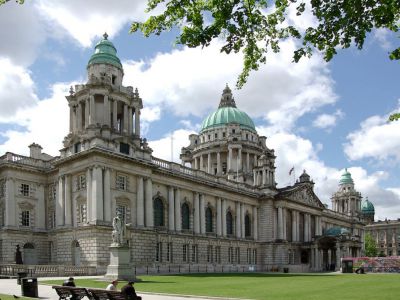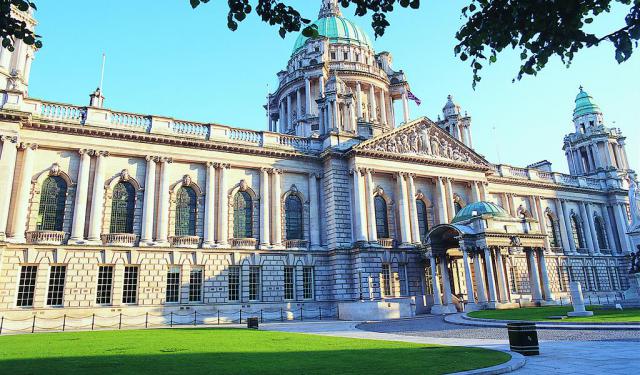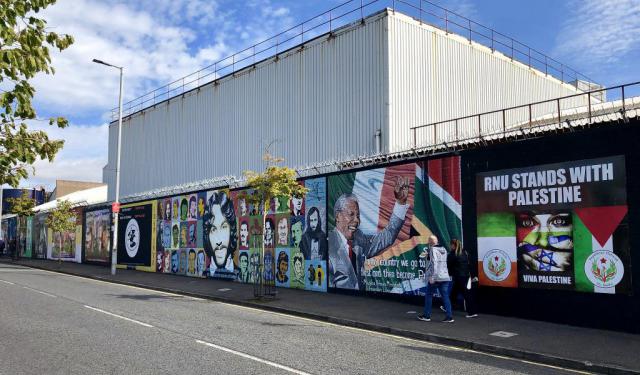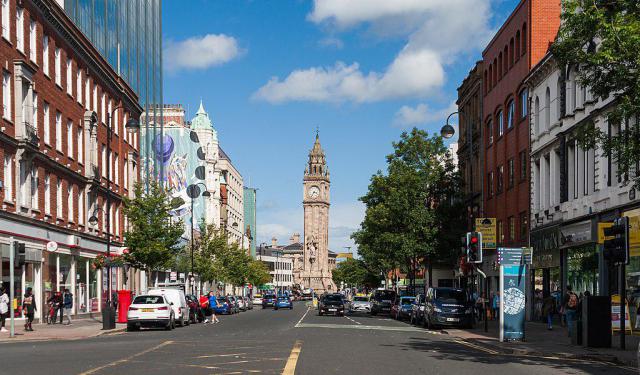
Belfast City Hall, Belfast (must see)
Belfast City Hall is the civic building of the Belfast City Council. Located in Donegall Square, it faces north and effectively divides the commercial and business areas of the city centre.
The site now occupied by Belfast City Hall was once the home of the White Linen Hall, an important international Linen Exchange. The Street that runs from the back door of Belfast City Hall through the middle of Linen Quarter is Linen Hall Street. Plans for the City Hall began in 1888 when Belfast was awarded city status by Queen Victoria. This was in recognition of Belfast's rapid expansion and thriving linen, rope-making, shipbuildingand engineering industries. During this period Belfast briefly overtook Dublin as the most populous city on the island of Ireland. Construction began in 1898 under the supervision of architect Sir Alfred Brumwell Thomas and was completed in 1906.
The exterior is built mainly from Portland stone and is in the Baroque Revival style. It covers an area of one and a half acres and has an enclosed courtyard. Featuring towers at each of the four corners, with a lantern-crowned 173 ft (53 m) copper dome in the centre, the City Hall dominates the city centre skyline. As with other Victorian buildings in the city centre, the City Hall's copper-coated domes are a distinctive green. The pediment sculpture is by F. W. Pomeroy, assisted by local carver J. Edgar Winter, and features on the reverse side of the current series of £10, £20, £50 and £100 sterling banknotesissued by the Northern Bank.
The interior has a number of notable features, including The Porte-Cochère and Grand Entrance, The Grand Staircase, The Reception Room and The Great Hall. The latter was destroyed during the Belfast Blitz during WW2 and subsequently rebuilt. Various memorials are located in the building, including ones to Frederick Robert Chichester, Earl of Belfast, Sir Crawford and Lady McCullagh and the 36th (Ulster) Division.
The gardens surrounding the City Hall are a popular with office workers taking their lunch in the summer months, as well as tourists and teenagers gathering in their dozens to enjoy the green. Various statues stand on the grounds, including one of Queen Victoria by Sir Thomas Brock. There is also a granite column dedicated to the American Expeditionary Force. The grounds also house Northern Ireland's main war memorial, The Garden of Remembrance and Cenotaph, at which wreaths are laid on Remembrance Day.
The site now occupied by Belfast City Hall was once the home of the White Linen Hall, an important international Linen Exchange. The Street that runs from the back door of Belfast City Hall through the middle of Linen Quarter is Linen Hall Street. Plans for the City Hall began in 1888 when Belfast was awarded city status by Queen Victoria. This was in recognition of Belfast's rapid expansion and thriving linen, rope-making, shipbuildingand engineering industries. During this period Belfast briefly overtook Dublin as the most populous city on the island of Ireland. Construction began in 1898 under the supervision of architect Sir Alfred Brumwell Thomas and was completed in 1906.
The exterior is built mainly from Portland stone and is in the Baroque Revival style. It covers an area of one and a half acres and has an enclosed courtyard. Featuring towers at each of the four corners, with a lantern-crowned 173 ft (53 m) copper dome in the centre, the City Hall dominates the city centre skyline. As with other Victorian buildings in the city centre, the City Hall's copper-coated domes are a distinctive green. The pediment sculpture is by F. W. Pomeroy, assisted by local carver J. Edgar Winter, and features on the reverse side of the current series of £10, £20, £50 and £100 sterling banknotesissued by the Northern Bank.
The interior has a number of notable features, including The Porte-Cochère and Grand Entrance, The Grand Staircase, The Reception Room and The Great Hall. The latter was destroyed during the Belfast Blitz during WW2 and subsequently rebuilt. Various memorials are located in the building, including ones to Frederick Robert Chichester, Earl of Belfast, Sir Crawford and Lady McCullagh and the 36th (Ulster) Division.
The gardens surrounding the City Hall are a popular with office workers taking their lunch in the summer months, as well as tourists and teenagers gathering in their dozens to enjoy the green. Various statues stand on the grounds, including one of Queen Victoria by Sir Thomas Brock. There is also a granite column dedicated to the American Expeditionary Force. The grounds also house Northern Ireland's main war memorial, The Garden of Remembrance and Cenotaph, at which wreaths are laid on Remembrance Day.
Sight description based on Wikipedia.
Want to visit this sight? Check out these Self-Guided Walking Tours in Belfast. Alternatively, you can download the mobile app "GPSmyCity: Walks in 1K+ Cities" from Apple App Store or Google Play Store. The app turns your mobile device to a personal tour guide and it works offline, so no data plan is needed when traveling abroad.
Belfast City Hall on Map
Sight Name: Belfast City Hall
Sight Location: Belfast, Ireland (See walking tours in Belfast)
Sight Type: Attraction/Landmark
Guide(s) Containing This Sight:
Sight Location: Belfast, Ireland (See walking tours in Belfast)
Sight Type: Attraction/Landmark
Guide(s) Containing This Sight:
Walking Tours in Belfast, Ireland
Create Your Own Walk in Belfast
Creating your own self-guided walk in Belfast is easy and fun. Choose the city attractions that you want to see and a walk route map will be created just for you. You can even set your hotel as the start point of the walk.
Belfast Victorian Architecture Jewels
Described as “modestly scaled, undemonstrative, somewhat solid in aspect, and usually restrained (sometimes even austere) in its use of external decoration”, the urban landscape of Belfast has been influenced by the demands of shipbuilding and linen industry, much as transitioning between culture, arts, commerce, and education. Still, the architectural spectrum of the city is quite broad and... view more
Tour Duration: 2 Hour(s)
Travel Distance: 2.9 Km or 1.8 Miles
Tour Duration: 2 Hour(s)
Travel Distance: 2.9 Km or 1.8 Miles
The Troubles and Peace Process Landmarks
Decades past the official end of The Troubles in Belfast, the price of peace in Northern Ireland remains high. One of the means with which to secure it, back in 1969, was erecting a wall to physically separate the capital's warring Protestant and Catholic communities. Known since as the Peace Wall, the structure has become a popular tourist attraction for the multiple murals painted thereon... view more
Tour Duration: 1 Hour(s)
Travel Distance: 2.1 Km or 1.3 Miles
Tour Duration: 1 Hour(s)
Travel Distance: 2.1 Km or 1.3 Miles
Belfast Introduction Walking Tour
For over a century, the political situation of Belfast, the capital of Northern Ireland, has been the source of strife, first between the Crown-loyal Protestants and Irish Catholics, and more recently between the United Kingdom and the European Union.
Sitting on the banks of the River Lagan where it meets the Irish Sea, the city owes its name to this coastal condition, with "Belfast"... view more
Tour Duration: 2 Hour(s)
Travel Distance: 3.5 Km or 2.2 Miles
Sitting on the banks of the River Lagan where it meets the Irish Sea, the city owes its name to this coastal condition, with "Belfast"... view more
Tour Duration: 2 Hour(s)
Travel Distance: 3.5 Km or 2.2 Miles



